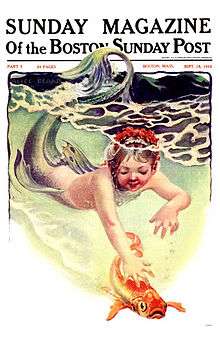The Boston Post
 The January 16, 1919 front page of The Boston Post | |
| Type | Daily newspaper |
|---|---|
| Format | Broadsheet |
| Owner(s) | Post Publishing Company |
| Founded | 1831[1] |
| Language | English |
| Ceased publication | 1956 |
| Headquarters |
42 Congress Street Boston, Massachusetts; Corner Devonshire & Water Streets, Boston, Massachusetts; 15–17 Milk Street, Boston, Massachusetts |
The Boston Post was a daily newspaper in New England for over a hundred years before it folded in 1956. The Post was founded in November 1831 by two prominent Boston businessmen, Charles G. Greene and William Beals.
Edwin Grozier bought the paper in 1891. Within two decades, he had built it into easily the largest paper in Boston and New England. He passed it to his son, Richard, upon his death in 1924. Under the younger Grozier, The Boston Post grew into one of the largest newspapers in the country. At its height in the 1930s, it had a circulation of well over a million readers. At the same time, Richard Grozier suffered an emotional breakdown from the death of his wife in childbirth from which he never recovered.
Throughout the 1940s, facing increasing competition from the Hearst-run papers in Boston and New York and from radio and television news, the paper began a decline from which it never recovered.
When it ceased publishing in October 1956, its daily circulation was 255,000 and Sunday circulation approximately 260,000.[2]
Former contributors
- Olin Downes, music critic.[3]
- Richard Frothingham, Jr., a Massachusetts historian, journalist, and politician who was a proprietor and managing editor of The Boston Post.
- Kenneth Roberts
- Olga Van Slyke Owens Huckins, literary editor, 1941 to 1954.[4] Huckins letter to Rachel Carson inspired the book Silent Spring.[5][6]
Sunday Magazine

The Boston Sunday Post
September 18, 1910.
Appearing in the Sunday paper every week was a weekly magazine. It was called first The Sunday Magazine of The Boston Sunday Post and later The Boston Sunday Post Sunday Magazine.
Pulitzer Prizes
- 1921 – Meritorious Public Service. The Boston Post was awarded the Pulitzer prize for its investigation and exposure of Charles Ponzi's financial fraud. Ponzi was first exposed by the investigative work directed by Richard Grozier (then acting publisher) and longtime city editor Edward Dunn, long time city editor, after complaints by Bostonians that the returns Ponzi offered were "too good to be true". It was the first time that a Boston paper had won a Pulitzer, and would be the last Pulitzer won for public service awarded to a Boston paper until the Globe won it in 2003.[7]
Boston Post cane tradition
In 1909, under the savvy ownership of Edwin Grozier, the Boston Post engaged in its most famous publicity stunt. The paper had several hundred ornate, gold-tipped canes made and contacted the selectmen in New England's largest towns. The Boston Post Canes were given to the selectmen and presented in a ceremony to the town's oldest living man.[8] The custom was expanded to include a community's oldest women in 1930. Many towns in New England still carry on the Boston Post cane tradition with the original canes they were awarded in 1909.[8]
See also
- New Boston Post
- The Boston Daily Advertiser
- The Boston Evening Transcript
- The Boston Globe
- The Boston Herald
- The Boston Journal
- The Boston Record
Image gallery
 The Boston Post Building 15–17 Milk Street, Boston, Massachusetts
The Boston Post Building 15–17 Milk Street, Boston, Massachusetts The Boston Sunday Post
The Boston Sunday Post
Sunday Magazine
July 5, 1914.
External links
| Wikimedia Commons has media related to The Boston Post. |
References
- ↑ The Encyclopaedia Britannica: A Dictionary of Arts, Sciences, Literature and General Information, Vol. 19, New York, NY: Encyclopaedia Britannica, 1911, p. 567.
- ↑ (4 October 1956). Boston Post Ceases Publication For 3rd Time in Last Three Months, Miami News (Associated Press story)
- ↑ Tommasini, Anthony (December 28, 2001), Edward Downes, 90, Opera Quizmaster, New York, NY: The New York Times
- ↑ Special to The New York Times (July 13, 1968), Olga Huckins, Ex-Editor At Boston Transcript, 67, New York, NY: New York Times, p. 27.
- ↑ Matthiessen, Peter (2007), Courage for the Earth: Writers, Scientists, and Activists Celebrate the Life and Writing of Rachel Carson, Boston, MA; New York, NY: Mariner Books, p. 135, ISBN 0-618-87276-0
- ↑ Himaras, Eleni (May 26, 2007), RACHEL'S LEGACY – Rachel Carson’s groundbreaking 'Silent Spring’ was inspired by Duxbury woman, Quincy, MA: The Patriot Ledger.
- ↑ Ponzi's Scheme, Mitchell Zukoff
- 1 2 "The Boston Post Cane" Information Center.